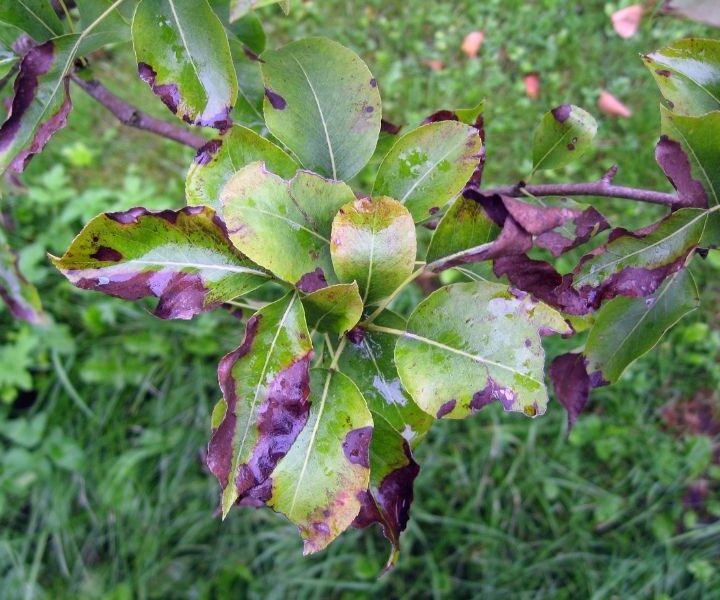Black Leaves on Pear Trees – Causes and Solutions
Pear trees are prized for their beauty and bounty of sweet delicious fruit. However pear tree leaves turning black is a common issue that can detract from the tree’s appearance and health. There are several potential causes for black leaves on a pear tree. Identifying the cause is key to treating the problem properly and restoring your tree’s vigor.
Common Causes of Black Pear Tree Leaves
Here are some of the most frequent reasons pear tree leaves may turn black:
Fire Blight – Fire blight is a bacterial disease that affects pear, apple, quince and other trees. It causes blackened leaves, flowers and twigs that look scorched. Oozing cankers may also form on branches and the trunk. Fire blight thrives in warm, humid conditions.
Water Issues – Too much or too little water can trigger blackened, drooping leaves. Pear trees need about 1-1.5 inches of water per week. Overwatering encourages root rot while underwatering leads to drought stress.
Nutrient Deficiency – Lack of key nutrients like nitrogen, iron, manganese or zinc can cause pear leaves to blacken and dieback. This is especially common in sandy, acidic or waterlogged soils.
Fungal Diseases – Fungal infections like scab, rust and black spot fungus can turn pear leaves black with spots or blotches. High humidity and poor air circulation favor fungal growth.
Pest Damage – Insects like aphids, psyllids, thrips, pear slugs and spider mites can all feed on leaves, causing stippling, spotting or scorching damage. Heavy infestations can blacken leaves.
Environmental Factors – Heat, cold, wind and air pollution can also take a toll on pear tree leaves. Scorching, marginal leaf burn and premature fall color can occur.
Root Damage – Construction activity, soil compaction, grade changes, or girdling roots can impair roots’ ability to take up moisture and nutrients. This leads to decline and blackened leaves.
How to Treat and Prevent Black Pear Leaves
If your pear tree has black leaves, take these steps to get it back to its healthy green glory:
-
Rule out causes – Check for signs of pests, disease, water issues, etc. to pinpoint the problem. An arborist can help diagnose.
-
Improve care – Adjust your watering schedule, fertilize if needed, and mulch to moderate soil moisture and temperature.
-
Increase air flow – Thin out branches for better light and air penetration, which deters fungal disease.
-
Prune affected parts – Selectively remove blackened or infected leaves, shoots and branches. Disinfect tools between cuts.
-
Apply pest/disease control – Use appropriate organic sprays like neem oil, insecticidal soap, copper, sulfur, etc. to treat pests and diseases present.
-
Monitor for recovery – Look for new leaf growth. It may take a while for the tree to rebound depending on the extent of damage.
-
Avoid unnecessary stress – Prevent future issues by caring properly for your tree with regular pruning, irrigation, and pest monitoring.
To prevent black pear leaves, promote vigorous pear tree health with:
-
Proper planting – Give it plenty of space, amended soil, sufficient sunlight and good drainage.
-
Routine care – Water, fertilize, prune and inspect your tree as needed.
-
Pest prevention – Maintain overall tree health to avoid making it more vulnerable to pests. Apply dormant oil spray.
-
Sanitation – Rake and dispose of fallen diseased leaves and fruit debris to minimize overwintering inoculum.
-
Protection from extremes – Mulch the root zone, provide temporary shading as needed, or use tree wrap to prevent winter injury, sunscald, etc.
With attention and care, your pear tree’s leaves can return to their proper green color. But blackened foliage is a signal something is wrong, so be sure to address the underlying cause for the best results. If black leaves persist or the tree seems to be in serious decline, consulting an ISA certified arborist can help get your pear tree back on track.
Fire Blight in Pear Trees Treatment
FAQ
How do you treat black leaves on a pear tree?
Why are my fruit tree leaves turning black?
How do you treat black rot on pears?
- A Complete Guide to Caring for Yuki Cherry Blossom Shrub - January 23, 2025
- Identifying Red Hot Poker Seeds: What to Look For When Harvesting Torch Lily Pods - January 23, 2025
- A Complete Guide to Harvesting Evening Primrose Seeds - January 23, 2025

